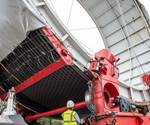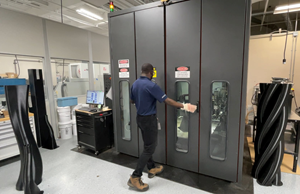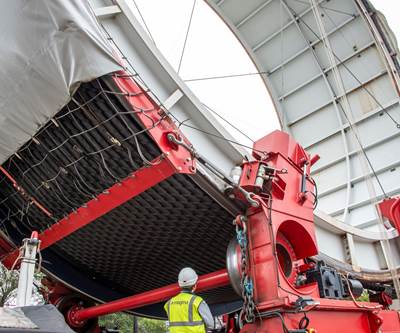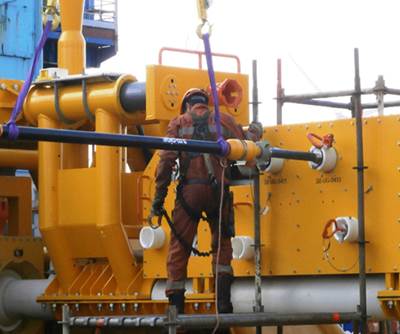Continuous thermoplastic composite pipe (TCP) manufactured in lengths up to 1.2 kilometers is wound onto 3-meter-diameter transportation spools, significantly reducing field joint requirements and enhancing installation efficiency compared to conventional steel solutions. Source (All Images) | Hive Composites
As the global shift toward cleaner energy sources intensifies, hydrogen has emerged as a crucial element in decarbonization strategies. Its versatility as a low-emission fuel at the point of use makes it applicable across various sectors. However, the effective use of hydrogen hinges on its safe and efficient transportation, a challenge that traditional steel pipeline infrastructure has struggled with due to issues like hydrogen embrittlement and high installation costs.
Thermoplastic composite pipe (TCP) technology offers a promising alternative, delivering significant performance and environmental advantages over conventional metallic systems. However, adapting TCP for hydrogen transport involves certain complexities due to the gas’s distinctive chemical and physical properties, requiring careful material selection and design optimization to ensure pipeline integrity and operational efficiency.
(Loughborough, U.K.) is one industry player that has developed an innovative TCP system — leveraging advanced composite materials and specialized manufacturing techniques — designed specifically for hydrogen applications. Peter Hansen, director at Hive Composites, emphasizes the significant impact of TCP on hydrogen infrastructure: “A carbon footprint analysis has shown that the global warming potential [GWP] of TCP is more than four times lower than that of equivalent steel pipes in the materials, manufacturing and transport phases. This represents a substantial reduction. Additionally, the operational and decommissioning emissions for TCP are approximately 60-70% lower than those for steel pipes of equivalent size.”
Hive Composites’ TCP system can be manufactured in continuous lengths of up to 1.2 kilometers (depending on the diameter), enabling efficient spooling and rapid installation while maintaining the structural integrity and gas permeability essential for safe hydrogen transport. This ability to produce long and continuous pipe not only reduces transportation and installation requirements but also enhances the overall sustainability of the technology. Designed to operate at pressures up to 100 bar and with diameters ranging from 2-6 inches, the TCP system is well-positioned to support hydrogen as a fuel and maximize its potential impact in the energy landscape.
Multilayer configuration, design strategy
The development of TCP for hydrogen applications required a careful approach to material selection, leading to a multilayer design focused on meeting performance metrics while ensuring compatibility at the system level. The final configuration features high-density polyethylene (HDPE) for both the inner and outer layers, augmented with glass fiber-reinforced polymer (GFRP) and other specialized barrier materials. These reinforcing layers are thermally fused together, resulting in a “fully bonded” composite structure that is designed to safely contain hydrogen over extended periods while maintaining full spoolability (more on this below).
The choice of HDPE was based on an in-depth analysis of the polymer’s qualities relevant to hydrogen services. “The tight molecular structure of HDPE provides inherent resistance to hydrogen permeation,” states Dr. Mat Turner, technical director at Hive Composites. “However, the criteria for selecting HDPE extended beyond its barrier properties to encompass a comprehensive range of operational demands.
“HDPE exhibits remarkable chemical resistance and the ability to resist stress cracking, which are critical for ensuring long-term durability under varying pressure and temperature regimes,” he elaborates. “Moreover, the polymer’s natural resistance to moisture absorption and its wide thermal stability range — from -40°C to 60°C — enhance consistent performance in diverse global service conditions. Additionally, its impact resistance exceeds that of some alternative thermoplastics, which is vital for installation and resilience against external damage.”
Glass fiber reinforcement approach
Various fiber-reinforced polymers were assessed for reinforcement; however, glass fiber was ultimately identified as the final choice for several reasons. Glass fiber not only provides optimal chemical resistance to hydrogen but also offers enhanced impact resistance compared to carbon fiber, which is crucial for handling during installation and ensuring long-term durability. A custom glass fiber/polyethylene (PE) tape formulation, incorporating fiber, sizing and a PE composition, was developed for these pipes to balance high performance with cost efficiency.
“The lower modulus and higher strain capacity of glass fiber are particularly beneficial for our TCP application,” Turner explains. “These traits allow for tighter spooling radii, increasing the amount of pipe transportable on each reel and enhancing installation efficiency, while also providing a cost-effective solution.”
Source | Hive Composites
The application of GFRP layers employs a tape construction that optimizes fiber alignment to ensure production consistency. This method builds upon established glass fiber/PE composite technologies, Hive Composites says, leveraging decades of material compatibility knowledge within the composites industry. The resulting composite structure achieves fiber volume fractions exceeding 60%, yielding mechanical properties that are said to rival traditional prepreg systems while maintaining ease of processing.
Barrier layer design
A specialized non-permeable barrier layer is strategically placed between the HDPE liner and the structural fiber reinforcement, crucial for effective hydrogen containment. While specific material details remain proprietary, Hansen notes that, “the barrier system uses thermoplastic polymers engineered for compatibility with the other layers, designed with precise processing techniques to ensure long-term structural integrity between layers. The multilayer design required careful consideration of thermal expansion coefficients and interfacial chemistry to maintain structural integrity throughout the operational temperature range. This was particularly important in developing joining methodologies, which ensure the continuity of the barrier layer at pipe junctions — essential for overall system performance.”
Thermal management, quality control integration
Hive Composites collaborated with Fibron Pipe (St. Valentin, Austria) to develop the advanced manufacturing system used to achieve hydrogen-capable TCP. This technique employs a thermal fusion methodology that features highly precise temperature management across multiple heating zones, along with customized cooling profiles designed to minimize residual stress.
The thermal management system accurately regulates energy input during both the preheating and consolidation stages. It incorporates hardware controlled by programmable logic controllers to ensure uniform energy distribution around the composite pipe’s circumference. Thermal imaging analysis confirms that temperature consistency is maintained within ±2°C across the entire pipe diameter during processing. This precision is crucial for ensuring uniform characteristics of the barrier layer and its structural integrity.
To enhance quality assurance beyond traditional visual inspections or periodic testing, the Fibron Pipe system also incorporates AI-driven technology, which enables it to perform thousands of real-time checks per minute throughout the manufacturing process. Key parameters monitored include the precision of tape placement, the gap width between adjacent tapes, the distribution of consolidation pressure and temperature uniformity.
These innovations lead to a TPC manufacturing process that not only maximizes production efficiency and quality control but also minimizes environmental impact. Energy consumption during production has been reduced compared to traditional TCP processes, and production rates have seen substantial improvements. Additionally, the long pipe lengths can be transported on 3-meter-diameter spools, which reduces transportation and installation requirements and costs, providing further sustainability benefits over steel.
Testing and validation framework
Hive Composites has established a comprehensive multi-tier testing pyramid that spans from thorough material characterization to complete system validation, aiming to qualify its TCP for hydrogen service.
The preliminary phase focused on characterizing individual material components to establish baseline properties and assess the technology’s environmental responses. The testing program evaluated the properties of the HDPE liner in various environments while concurrently assessing the durability of the glass fiber reinforcement under different exposure conditions. Key metrics analyzed included the permeation resistance of the barrier layer and the stability of interfacial bonds between composite layers. Regression testing of tapes and liners through accelerated aging programs lasting up to 10,000 hours allows projections of data applicable to 20 or 30 years of service with a greater degree of certainty.
Specialized composite tape tensile testing apparatus developed by Hive Composites features a gripping system that eliminates edge stress concentrations, enabling accurate characterization of unidirectional (UD) glass fiber-reinforced tapes.
A pivotal innovation in this phase was the development of a specialized testing apparatus for high-strength unidirectional (UD) tapes. Traditional testing methods often resulted in premature edge failures due to stress concentrations at the specimen gripping mechanism interface, which obscured the true capabilities of the material. “Our gripping system alleviates stress concentrations, ensuring that failures occur within the gage length, leading to more representative results,” Hansen explains. “This advancement was instrumental in accurately characterizing material performance under operational conditions.”
At Hive Composites’ hydrogen exposure testing facility material specimens undergo controlled, long-term exposure to hydrogen at elevated temperatures (up to 60°C) for durations extending to 10,000 hours to validate material stability and assess potential degradation mechanisms.
To investigate long-term material behavior, Hive Composites devised specialized accelerated aging protocols. Specimens were subjected to hydrogen, air and water at 60°C for up to 10,000 hours, with systematic evaluations of mechanical properties conducted after periodic exposure. A distinctive feature of this program was the maintenance of constant strain on the reinforcement tapes during environmental exposure, which simulated service conditions with sustained pressure more accurately.
“Our permeation testing methodology, refined from the ISO 15105-1 pressure sensor method and performed in-house, accommodated both flat specimens and full pipe sections,” says Hansen. “Our tests evaluated pressures up to 100 bar and temperatures ranging from ambient to 80°C, while continuously monitoring the permeated gas pressure and analyzing both steady-state and transient permeation behavior.”
The full-scale pipe testing program, which led to demonstrations at two sites, was developed in close collaboration with Det Norske Veritas (DNV, Høvik, Norway) and conducted in-house at Hive Composites. The finalized test framework validates the effectiveness of Hive Composites’ current design and manufacturing methodologies for safe, hydrogen-capable TCP.
“Our testing adhered to protocols adapted from DNV-ST-F119 and API 15S standards specifically tailored for nonmetallic composite pipes used in gas transport, with modifications to ensure compliance with hydrogen service requirements,” Hansen notes. “This comprised assessments of short-term burst pressure, long-term regression, cyclic pressure loading, rapid gas decompression resistance, spoolability verification and joint integrity evaluations.”
To help develop standards for hydrogen TCP, Hive is also a partner in a joint industry project run by DNV aimed at identifying and addressing existing gaps in traditional TCP standards that overlook practical considerations associated with hydrogen service, which can lead to significant oversights. This initiative revealed critical areas requiring enhanced validation procedures, including the standardization of hydrogen permeation measurement methods.
Performance data, test results validate system robustness
Permeation testing conducted over an extended period at a pressure of 70 bar highlighted the benefits of the multilayer design. “The analysis of the HDPE liner alone indicated a temperature-dependent variation in hydrogen permeation rates at 60°C,” Hansen observed. “The addition of a specialized barrier layer reduced these coefficients by three orders of magnitude. Furthermore, when we included thermally fused layers, we detected no permeation during the 4-month test. This result aligned very well with the full pipe tests.”
Accelerated aging studies revealed that the HDPE liner material showed no signs of chemical degradation after being exposed to hydrogen for up to 10,000 hours at 60°C. Mechanical property evaluations of hydrogen-saturated specimens indicated that any changes were reversible, with complete recovery occurring once hydrogen was removed. In contrast, exposure to water had a more significant impact on the degradation of glass fibers compared to hydrogen, as anticipated. Testing the tapes in water, while an extreme scenario, has proven to be an effective method for evaluating and screening different tape formulations, helping to select materials for the final product.
Structural performance evaluations, conducted through regression testing of the full pipe system (including both pipe and fittings), have established the long-term pressure rating of the system. Hansen elaborates, “Analysis of time-to-failure data across various pressure levels produced a regression curve that indicates consistent performance significantly exceeding the design requirements for hydrogen service, showcasing a predicted service life of more than 30 years under normal operating conditions. The design approach adopted also allows for accommodating a longer service life.
Test section of Hive's hydrogen-specific TCP is prepared for pressure testing, where the pipe was subjected to pressurized hydrogen service for 2 months before undergoing validation of interfacial bonding integrity.
“The structural performance during rapid decompression events has been particularly impressive,” Hansen adds. “Recent tests conducted at demonstration sites in Holland and the U.K. — specifically at the DNV Spadeadam site — subjected the pipe to pressurized hydrogen service for 2 months before performing rapid decompression tests. Post-test inspections revealed no permeation through the pipe wall or commercial fittings during this trial, and there was no degradation in interface properties or structural integrity, even under conditions designed to stress interface boundaries. These findings validate the system’s robustness and the effectiveness of the manufacturing process in maintaining structural cohesion under extreme conditions.”
Environmental impact assessment
Data from Hive Composites and Fibron Pipe indicate that average installation speeds for TCP are around one kilometer per day, which is approximately 40 times faster than traditional steel pipeline installations. While the material costs for TCP are comparable to those of steel alternatives, the installation expenses are significantly lower. A total cost analysis evaluated over a 20-year service life has shown that adopting hydrogen-capable TCP is at least four times more economical than using traditional steel solutions
Field demonstration installation of Hive Composites' TCP system at a hydrogen testing facility, operating at 70 bar with 100% hydrogen, showcases the pipeline system in operation.
A carbon footprint analysis was conducted using the “cradle-to-gate” approach, which covers all significant energy and material consumption during the manufacturing process of TCP. This includes upstream greenhouse gas emissions related to materials, transportation and waste. The Product Carbon Footprint of Hive’s TCP system shows a GWP of 11 kg CO2-equivalent compared to 40-50 kg CO2-equivalent for steel pipes, indicating a significant reduction in emissions. Moreover, the operational and decommissioning emissions for TCP are approximately 60-70% lower than those for steel pipes. The capability to produce continuous pipe lengths of 1-2 kilometers significantly reduces the number of required field joints, thereby enhancing both installation efficiency and long-term reliability.
Further analysis indicates that Hive Composites’ multilayer TCP system demonstrates significant potential for carbon capture and storage applications, as the composite structure’s inherent corrosion resistance addresses the challenges posed by carbonic acid formation in COâ‚‚ transport pipelines, while the adaptable barrier technology can be optimized for COâ‚‚ permeation resistance, providing a versatile alternative pathway for decarbonization infrastructure should hydrogen distribution networks face implementation delays.
Related Content
Eaton developing carbon-reinforced PEKK to replace aluminum in aircraft air ducts
3D printable material will meet ESD, flammability and other requirements to allow for flexible manufacturing of ducts, without tooling needed today.
Read MoreThermoplastic composites: Cracking the horizontal body panel nut
Versatile sandwich panel technology solves decades-long exterior automotive challenge.
Read MoreCombining multifunctional thermoplastic composites, additive manufacturing for next-gen airframe structures
The DOMMINIO project combines AFP with 3D printed gyroid cores, embedded SHM sensors and smart materials for induction-driven disassembly of parts at end of life.
Read MoreUpdate: THOR project for industrialized, recyclable thermoplastic composite tanks for hydrogen storage
A look into the tape/liner materials, LATW/recycling processes, design software and new equipment toward commercialization of Type 4.5 tanks.
Read MoreRead Next
Thermoplastic composite pipe on the rise in the deep sea
Demonstrators, pilot programs and qualification efforts are paying off as thermoplastic composite pipe (TCP) makers take orders for deep-sea oil and gas applications.
Read MoreMaterial supplier, manufacturer marry in oil and gas
Victrex and Magma Global, which have a long history of cooperation in the oil and gas industry, inched closer together with Victrex taking a minority interest in the composite pipe manufacturer.
Read MoreNext-gen fan blades: Hybrid twin RTM, printed sensors, laser shock disassembly
MORPHO project demonstrates blade with 20% faster RTM cure cycle, uses AI-based monitoring for improved maintenance/life cycle management and proves laser shock disassembly for recycling.
Read More













